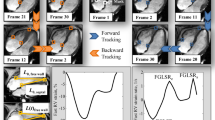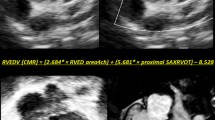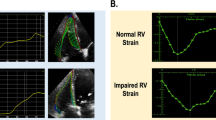Abstract
Right ventricular (RV) volumetric cardiac magnetic resonance (CMR) criteria serve as indicators for pulmonary valve replacement (PVR) in repaired tetralogy of Fallot (rTOF). Myocardial deformation and tricuspid valve displacement parameters may be more sensitive measures of RV dysfunction. This study’s aim was to describe rTOF RV deformation and tricuspid displacement patterns using novel CMR semi-automated software and determine associations with standard CMR measures. Retrospective study of 78 pediatric rTOF patients was compared to 44 normal controls. Global RV longitudinal and circumferential strain and strain rate (SR) and tricuspid valve (TV) displacement were measured. Correlation analysis between strain, SR, TV displacement, and volumes was performed between and within subgroups. The sensitivity and specificity of strain parameters in predicting CMR criteria for PVR was determined. Deformation variables were reduced in rTOF compared to controls. Decreased RV strain and TV shortening were associated with increased RV volumes and decreased RVEF. Longitudinal and circumferential parameters were predictive of RVESVi (> 80 ml/m2) and RVEF (< 47%), with circumferential strain (> − 15.88%) and SR (> − 0.62) being most sensitive. Longitudinal strain was unchanged between rTOF subgroups, while circumferential strain trended abnormal in those meeting PVR criteria compared to controls. RV deformation and TV displacement are abnormal in rTOF, and RV circumferential strain variation may reflect an adaptive response to chronic volume or pressure load. This coupled with associations of ventricular deformation with traditional PVR indications suggest importance of this analysis in the evolution of rTOF RV assessment.




Similar content being viewed by others
Availability of Data and Material
The datasets used and/or analyzed during the current study are available from the corresponding author on reasonable request.
Code Availability
Not applicable.
Abbreviations
- RV:
-
Right ventricle
- TOF:
-
Tetralogy of Fallot
- rTOF:
-
Repaired tetralogy of Fallot
- CMR:
-
Cardiac magnetic resonance imaging
- PVR:
-
Pulmonary valve replacement
- RVEF:
-
Right ventricular ejection fraction
- TV:
-
Tricuspid valve
- LV:
-
Left ventricular
- SR:
-
Strain rate
- ROC:
-
Receiver operator characteristics
- TAPSE:
-
Tricuspid annular plane systolic excursion
References
Lillehei CW, Varco RL, Cohen M et al (1986) The first open heart corrections of tetralogy of Fallot. A 26–31 year follow-up of 106 patients. Ann Surg 204:490–502
Murphy JG, Gersh BJ, Mair DD et al (1993) Long-term outcome in patients undergoing surgical repair of tetralogy of Fallot. N Engl J Med 329:593–599. https://doi.org/10.1056/NEJM199308263290901
Frigiola A, Tsang V, Bull C et al (2008) Biventricular response after pulmonary valve replacement for right ventricular outflow tract dysfunction: is age a predictor of outcome? Circulation 118:S182-190. https://doi.org/10.1161/CIRCULATIONAHA.107.756825
Marie PY, Marçon F, Brunotte F et al (1992) Right ventricular overload and induced sustained ventricular tachycardia in operatively “repaired” tetralogy of Fallot. Am J Cardiol 69:785–789
Friedberg MK, Fernandes FP, Roche SL et al (2013) Relation of right ventricular mechanics to exercise tolerance in children after tetralogy of Fallot repair. Am Heart J 165:551–557. https://doi.org/10.1016/j.ahj.2012.06.029
Knauth AL, Gauvreau K, Powell AJ et al (2008) Ventricular size and function assessed by cardiac MRI predict major adverse clinical outcomes late after tetralogy of Fallot repair. Heart Br Card Soc 94:211–216. https://doi.org/10.1136/hrt.2006.104745
Geva T, Sandweiss BM, Gauvreau K et al (2004) Factors associated with impaired clinical status in long-term survivors of tetralogy of Fallot repair evaluated by magnetic resonance imaging. J Am Coll Cardiol 43:1068–1074. https://doi.org/10.1016/j.jacc.2003.10.045
Ghai A, Silversides C, Harris L et al (2002) Left ventricular dysfunction is a risk factor for sudden cardiac death in adults late after repair of tetralogy of Fallot. J Am Coll Cardiol 40:1675–1680
Lu JC, Ghadimi Mahani M, Agarwal PP et al (2013) Usefulness of right ventricular free wall strain to predict quality of life in “repaired” tetralogy of Fallot. Am J Cardiol 111:1644–1649. https://doi.org/10.1016/j.amjcard.2013.01.336
Valente AM, Cook S, Festa P et al (2014) Multimodality imaging guidelines for patients with repaired tetralogy of fallot: a report from the AmericanSsociety of Echocardiography: developed in collaboration with the Society for Cardiovascular Magnetic Resonance and the Society for Pediatric Radiology. J Am Soc Echocardiogr Off Publ Am Soc Echocardiogr 27:111–141. https://doi.org/10.1016/j.echo.2013.11.009
Geva T (2013) Indications for pulmonary valve replacement in repaired tetralogy of fallot: the quest continues. Circulation 128:1855–1857. https://doi.org/10.1161/CIRCULATIONAHA.113.005878
Therrien J, Provost Y, Merchant N et al (2005) Optimal timing for pulmonary valve replacement in adults after tetralogy of Fallot repair. Am J Cardiol 95:779–782. https://doi.org/10.1016/j.amjcard.2004.11.037
Oosterhof T, van Straten A, Vliegen HW et al (2007) Preoperative thresholds for pulmonary valve replacement in patients with corrected tetralogy of Fallot using cardiovascular magnetic resonance. Circulation 116:545–551. https://doi.org/10.1161/CIRCULATIONAHA.106.659664
Orwat S, Diller G-P, Kempny A et al (2016) Myocardial deformation parameters predict outcome in patients with repaired tetralogy of Fallot. Heart Br Card Soc 102:209–215. https://doi.org/10.1136/heartjnl-2015-308569
Tham EB, Smallhorn JF, Kaneko S et al (2014) Insights into the Evolution of Myocardial Dysfunction in the Functionally Single Right Ventricle between Staged Palliations Using Speckle-Tracking Echocardiography. J Am Soc Echocardiogr 27:314–322. https://doi.org/10.1016/j.echo.2013.11.012
Cho G-Y, Marwick TH, Kim H-S et al (2009) Global 2-dimensional strain as a new prognosticator in patients with heart failure. J Am Coll Cardiol 54:618–624. https://doi.org/10.1016/j.jacc.2009.04.061
Almeida-Morais L, Pereira-da-Silva T, Branco L et al (2017) The value of right ventricular longitudinal strain in the evaluation of adult patients with repaired tetralogy of Fallot: a new tool for a contemporary challenge. Cardiol Young 27:498–506. https://doi.org/10.1017/S1047951116000810
Moon TJ, Choueiter N, Geva T et al (2015) Relation of biventricular strain and dyssynchrony in repaired tetralogy of fallot measured by cardiac magnetic resonance to death and sustained ventricular tachycardia. Am J Cardiol 115:676–680. https://doi.org/10.1016/j.amjcard.2014.12.024
Kempny A, Diller G-P, Orwat S et al (2012) Right ventricular-left ventricular interaction in adults with Tetralogy of Fallot: a combined cardiac magnetic resonance and echocardiographic speckle tracking study. Int J Cardiol 154:259–264. https://doi.org/10.1016/j.ijcard.2010.09.031
Diller G-P, Kempny A, Liodakis E et al (2012) Left ventricular longitudinal function predicts life-threatening ventricular arrhythmia and death in adults with repaired tetralogy of fallot. Circulation 125:2440–2446. https://doi.org/10.1161/CIRCULATIONAHA.111.086983
Kempny A, Fernández-Jiménez R, Orwat S et al (2012) Quantification of biventricular myocardial function using cardiac magnetic resonance feature tracking, endocardial border delineation and echocardiographic speckle tracking in patients with repaired tetralogy of Fallot and healthy controls. J Cardiovasc Magn Reson Off J Soc Cardiovasc Magn Reson 14:32. https://doi.org/10.1186/1532-429X-14-32
Koestenberger M, Avian A, Cantinotti M, Hansmann G (2019) Tricuspid annular plane systolic excursion (TAPSE) in pediatric pulmonary hypertension: Integrating right ventricular ejection efficiency (RVEe) into advanced multi-parametric imaging. Int J Cardiol 274:296–298. https://doi.org/10.1016/j.ijcard.2018.07.013
Koestenberger M, Ravekes W, Everett AD et al (2009) Right Ventricular Function in Infants, Children and Adolescents: Reference Values of the Tricuspid Annular Plane Systolic Excursion (TAPSE) in 640 Healthy Patients and Calculation of z Score Values. J Am Soc Echocardiogr 22:715–719. https://doi.org/10.1016/j.echo.2009.03.026
Koestenberger M, Nagel B, Ravekes W et al (2011) Tricuspid annular plane systolic excursion and right ventricular ejection fraction in pediatric and adolescent patients with tetralogy of Fallot, patients with atrial septal defect, and age-matched normal subjects. Clin Res Cardiol 100:67–75. https://doi.org/10.1007/s00392-010-0213-z
Villafañe J, Feinstein JA, Jenkins KJ et al (2013) Hot Topics in Tetralogy of Fallot. J Am Coll Cardiol 62:2155–2166. https://doi.org/10.1016/j.jacc.2013.07.100
Yim D, Mertens L, Morgan CT et al (2017) Impact of surgical pulmonary valve replacement on ventricular mechanics in children with repaired tetralogy of Fallot. Int J Cardiovasc Imaging 33:711–720. https://doi.org/10.1007/s10554-016-1046-2
Haggerty CM, Suever JD, Pulenthiran A et al (2017) Association between left ventricular mechanics and diffuse myocardial fibrosis in patients with repaired Tetralogy of Fallot: a cross-sectional study. J Cardiovasc Magn Reson Off J Soc Cardiovasc Magn Reson 19:100. https://doi.org/10.1186/s12968-017-0410-2
Punithakumar K, Noga M, Ben Ayed I, Boulanger P (2015) Right ventricular segmentation in cardiac MRI with moving mesh correspondences. Comput Med Imaging Graph 43:15–25. https://doi.org/10.1016/j.compmedimag.2015.01.004
Punithakumar K, Boulanger P, Noga M (2017) A GPU-Accelerated Deformable Image Registration Algorithm With Applications to Right Ventricular Segmentation. IEEE Access 5:20374–20382. https://doi.org/10.1109/ACCESS.2017.2755863
Petitjean C, Zuluaga MA, Bai W et al (2015) Right ventricle segmentation from cardiac MRI: A collation study. Med Image Anal 19:187–202. https://doi.org/10.1016/j.media.2014.10.004
Dice L (1945) Measures of the Amount of Ecologic Association Between Species. Ecology 26:297–302
Mandrekar JN (2010) Receiver Operating Characteristic Curve in Diagnostic Test Assessment. J Thorac Oncol 5:1315–1316. https://doi.org/10.1097/JTO.0b013e3181ec173d
Virtanen P, Gommers R et al (2020) SciPy 1.0: fundamental algorithms for scientific computing in Python. Nat Methods 17:261–272. https://doi.org/10.1038/s41592-019-0686-2
Buechel ERV, Dave HH, Kellenberger CJ et al (2005) Remodelling of the right ventricle after early pulmonary valve replacement in children with repaired tetralogy of Fallot: assessment by cardiovascular magnetic resonance. Eur Heart J 26:2721–2727. https://doi.org/10.1093/eurheartj/ehi581
Quail MA, Frigiola A, Giardini A et al (2012) Impact of pulmonary valve replacement in tetralogy of Fallot with pulmonary regurgitation: a comparison of intervention and nonintervention. Ann Thorac Surg 94:1619–1626. https://doi.org/10.1016/j.athoracsur.2012.06.062
Cheung EW-Y, Wong WH-S, Cheung Y-F (2010) Meta-analysis of pulmonary valve replacement after operative repair of tetralogy of fallot. Am J Cardiol 106:552–557. https://doi.org/10.1016/j.amjcard.2010.03.065
Sanchez-Quintana D, Anderson RH, Ho SY (1996) Ventricular myoarchitecture in tetralogy of Fallot. Heart Br Card Soc 76:280–286
Geva T (2011) Repaired tetralogy of Fallot: the roles of cardiovascular magnetic resonance in evaluating pathophysiology and for pulmonary valve replacement decision support. J Cardiovasc Magn Reson Off J Soc Cardiovasc Magn Reson 13:9. https://doi.org/10.1186/1532-429X-13-9
Dragulescu A, Grosse-Wortmann L, Redington A et al (2013) Differential effect of right ventricular dilatation on myocardial deformation in patients with atrial septal defects and patients after tetralogy of Fallot repair. Int J Cardiol 168:803–810. https://doi.org/10.1016/j.ijcard.2012.10.009
Weidemann F, Eyskens B, Mertens L et al (2002) Quantification of regional right and left ventricular function by ultrasonic strain rate and strain indexes after surgical repair of tetralogy of Fallot. Am J Cardiol 90:133–138
Sabate Rotes A, Bonnichsen CR, Reece CL et al (2014) Long-term follow-up in repaired tetralogy of fallot: can deformation imaging help identify optimal timing of pulmonary valve replacement? J Am Soc Echocardiogr Off Publ Am Soc Echocardiogr 27:1305–1310. https://doi.org/10.1016/j.echo.2014.09.012
Khoo NS, Smallhorn JF, Kaneko S et al (2011) Novel insights into RV adaptation and function in hypoplastic left heart syndrome between the first 2 stages of surgical palliation. JACC Cardiovasc Imaging 4:128–137. https://doi.org/10.1016/j.jcmg.2010.09.022
Brooks PA, Khoo NS, Mackie AS, Hornberger LK (2012) Right ventricular function in fetal hypoplastic left heart syndrome. J Am Soc Echocardiogr 25:1068–1074. https://doi.org/10.1016/j.echo.2012.06.005
Karamlou T, Giraud GD, McKeogh D et al (2019) Right ventricular remodeling in response to volume overload in fetal sheep. Am J Physiol-Heart Circ Physiol 316:H985–H991. https://doi.org/10.1152/ajpheart.00439.2018
Sedmera D, Pexieder T, Rychterova V et al (1999) Remodeling of chick embryonic ventricular myoarchitecture under experimentally changed loading conditions. Anat Rec 254:238–252
Sedmera D, Pexieder T, Vuillemin M et al (2000) Developmental patterning of the myocardium. Anat Rec 258:319–337
Manisty CH, Francis DP (2008) Ejection fraction: a measure of desperation? Heart Br Card Soc 94:400–401. https://doi.org/10.1136/hrt.2007.118976
Alvarez SV, Fortin-Pellerin E, Alhabdan M et al (2017) Strain rate in children and young piglets mirrors changes in contractility and demonstrates a force-frequency relationship. J Am Soc Echocardiogr Off Publ Am Soc Echocardiogr 30:797–806. https://doi.org/10.1016/j.echo.2017.04.001
Tang D, Yang C, del Nido PJ et al (2016) Mechanical stress is associated with right ventricular response to pulmonary valve replacement in patients with repaired tetralogy of Fallot. J Thorac Cardiovasc Surg 151:687-694.e3. https://doi.org/10.1016/j.jtcvs.2015.09.106
Moiduddin N, Texter KM, Cheatham JP et al (2012) Strain echocardiographic assessment of ventricular function after percutaneous pulmonary valve implantation. Congenit Heart Dis 7:361–371. https://doi.org/10.1111/j.1747-0803.2012.00680.x
Lang RM, Badano LP, Mor-Avi V et al (2015) Recommendations for cardiac chamber quantification by echocardiography in adults: an update from the American Society of Echocardiography and the European Association of Cardiovascular Imaging. Eur Heart J Cardiovasc Imaging 16:233–270. https://doi.org/10.1093/ehjci/jev014
DiLorenzo MP, Elci OU, Wang Y et al (2018) Longitudinal Changes in Right Ventricular Function in Tetralogy of Fallot in the Initial Years after Surgical Repair. J Am Soc Echocardiogr 31:816–821. https://doi.org/10.1016/j.echo.2018.02.013
Acknowledgements
We thank Sevier Canada for funding of the Servier Virtual Cardiac Centre and partial funding of Dr Punithakumar’s employment.
Funding
Servier Canada funded the Servier 3D Virtual Cardiac Centre where part of the research analysis was performed. General funds of the Servier 3D Virtual Cardiac Centre were used to purchase scanning time on a research magnet for the healthy volunteer’s cohort.
Author information
Authors and Affiliations
Contributions
MN initiated the study design and obtained ethics approval, collected the normal controls, and analyzed their data. BG collected and analyzed all the CMR data, performed statistical analysis, and prepared the manuscript. KP designed the strain analysis software with continued upgrades of the software to improve tracking. DK provided additional statistical analysis for the strain, multi-variate, L/C ratio, intra-observer, and inter-observer analyses. ET performed the TV displacement analysis, provided additional statistical analysis, and made significant contributions to completing the manuscript including formatting the figures and tables. All authors contributed to revising and approving the final manuscript.
Corresponding author
Ethics declarations
Conflict of Interest
Each author states there is no potential, perceived, or real conflicts of interest.
Ethical Approval
The Health Research Ethics Board at the University of Alberta approved this retrospective study. Given the retrospective nature and minimal risk to patients, the need for consent to participate in this study was waived.
Consent for Participate
Not applicable.
Consent for Publication
Not applicable.
Additional information
Publisher's Note
Springer Nature remains neutral with regard to jurisdictional claims in published maps and institutional affiliations.
Rights and permissions
About this article
Cite this article
Goot, B.H., Tham, E.B., Krishnaswamy, D. et al. Cardiac MRI-Derived Myocardial Deformation Parameters Correlate with Pulmonary Valve Replacement Indications in Repaired Tetralogy of Fallot. Pediatr Cardiol 42, 1805–1817 (2021). https://doi.org/10.1007/s00246-021-02669-z
Received:
Accepted:
Published:
Issue Date:
DOI: https://doi.org/10.1007/s00246-021-02669-z




